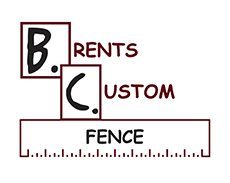Transform Your Property with Style and Function
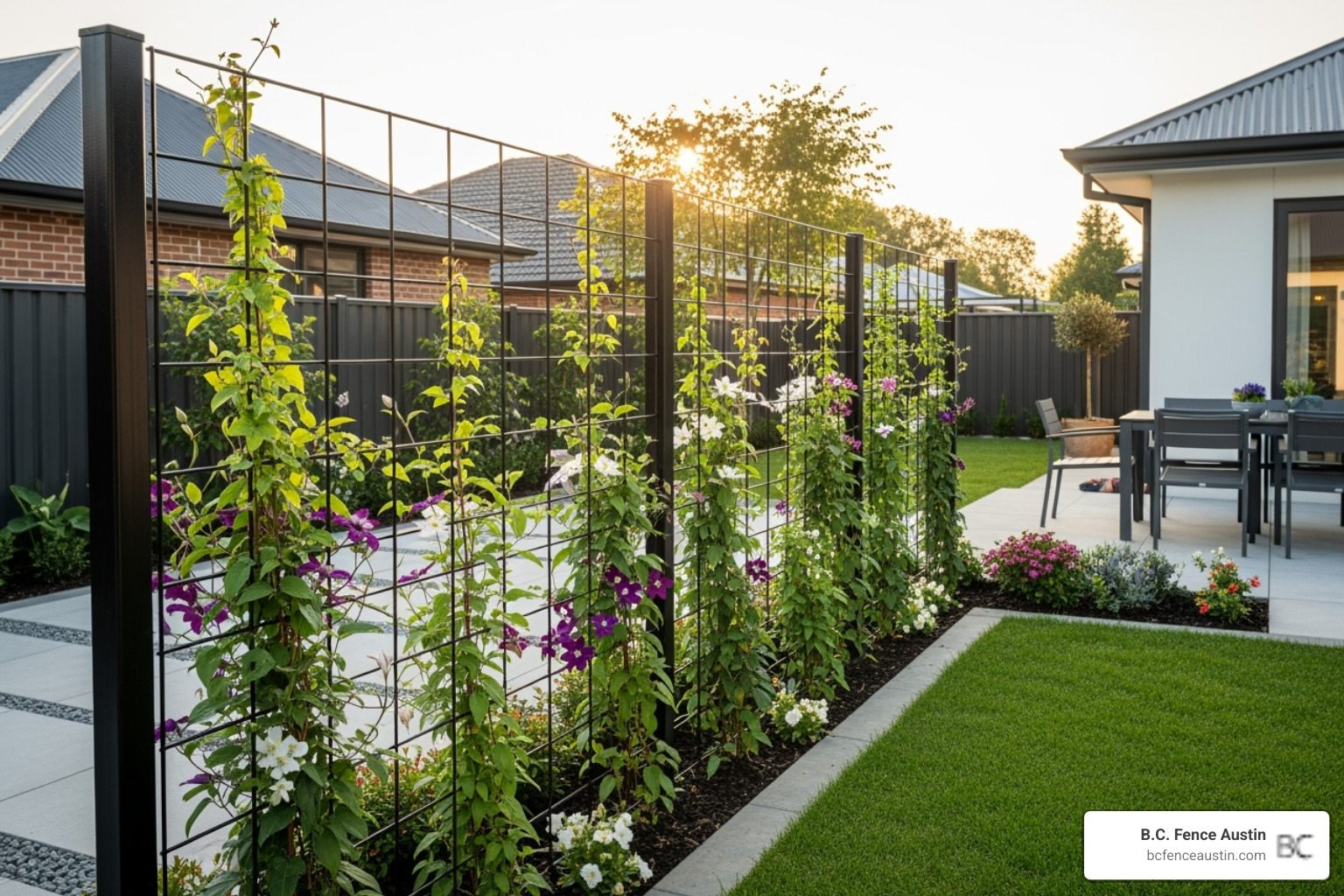
A decorative cattle panel fence combines the rugged durability of agricultural fencing with modern design aesthetics to create stunning property boundaries. These versatile fences offer homeowners an affordable way to add both security and visual appeal to their yards.
Quick Answer for Decorative Cattle Panel Fence:
- What it is: Heavy-duty galvanized wire panels (typically 50 inches tall, 16 feet long) framed with wood or metal
- Key benefits: Durable, cost-effective, allows airflow and visibility while providing security
- Best uses: Property boundaries, garden trellises, pet enclosures, modern farmhouse aesthetics
- Installation: DIY-friendly with proper framing and post support
- Customization: Paint finishes, climbing plants, integrated lighting, privacy slats
Gone are the days when cattle panels were limited to farms and ranches. Today’s homeowners are finding what agricultural communities have known for decades – these four-gauge galvanized wire panels offer best strength and longevity at a fraction of the cost of traditional decorative fencing.
The beauty of cattle panel fencing lies in its open design. Unlike solid privacy fences that can make yards feel enclosed, cattle panels maintain visual flow while still defining boundaries. This makes them perfect for Hannah’s needs – creating security for children and pets without sacrificing the open feel of her landscape.
Whether you’re drawn to the rustic charm of a cedar-framed cattle panel fence or prefer the sleek industrial look of black powder-coated metal frames, these versatile panels adapt to virtually any design style. From modern minimalist to farmhouse chic, cattle panels serve as the perfect foundation for your creative vision.
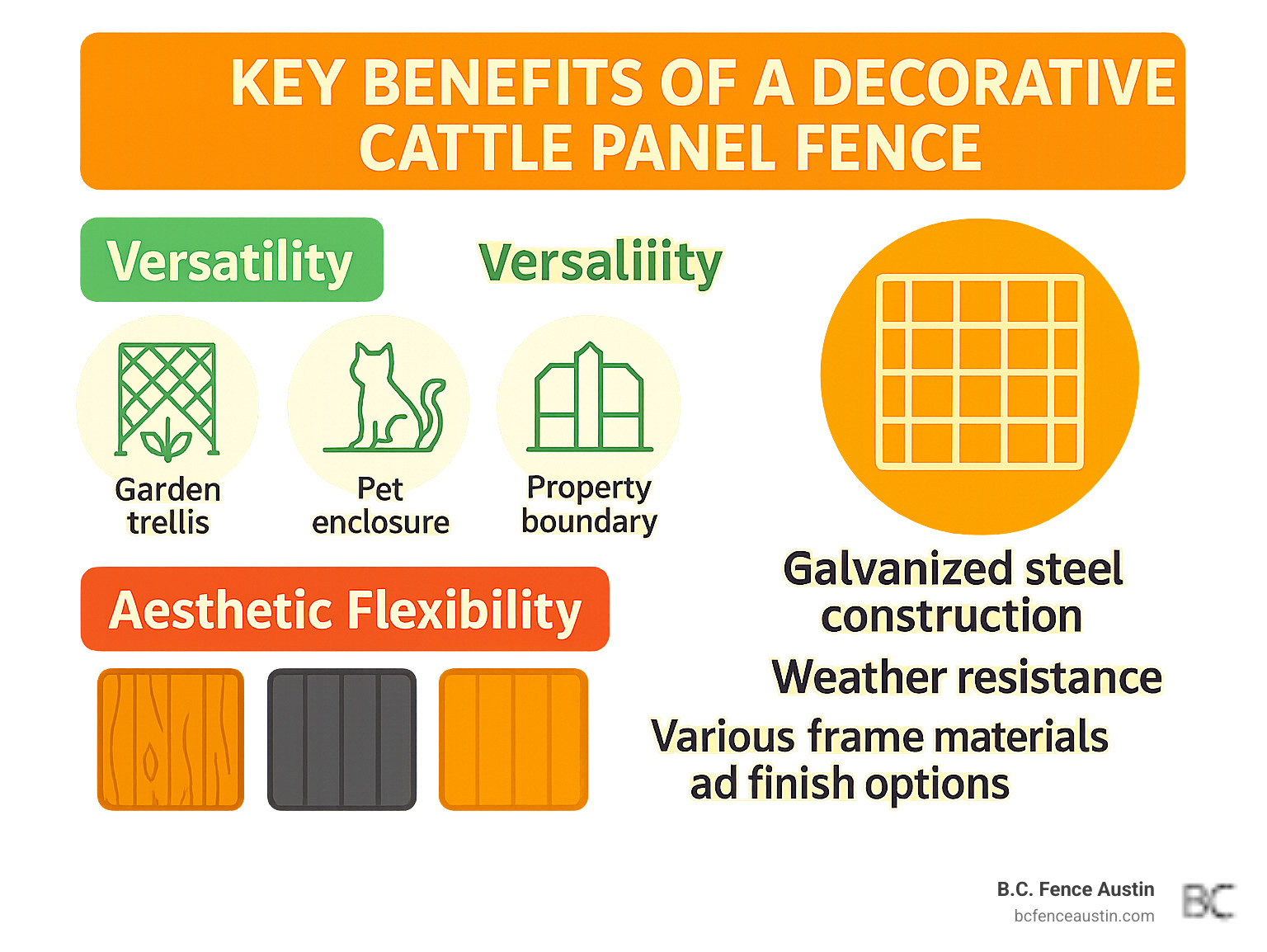
Why Choose a Cattle Panel Fence for a Decorative Touch?
If you’re looking to upgrade your outdoor space, a decorative cattle panel fence offers something special that traditional fencing just can’t match. These aren’t your grandfather’s farm fences anymore – they’ve evolved into a stylish solution that brings together the best of both worlds: rock-solid durability and eye-catching design.
The secret lies in their construction. Made from four-gauge galvanized wire that’s welded together for extra strength, these panels are built to handle whatever Mother Nature throws their way. The galvanized coating provides exceptional weather resistance and keeps rust at bay, which means you’ll spend more time enjoying your fence and less time maintaining it. We’re talking about genuine longevity here – these fences can look great for decades with minimal upkeep.
But strength isn’t everything. What really sets cattle panel fences apart is their open design that creates unobstructed views while still defining your space. Unlike solid privacy fences that can make your yard feel boxed in, cattle panels let you enjoy your garden and the scenery beyond. Your property feels more spacious and connected to its surroundings.
The versatility is remarkable too. Whether you want rustic farmhouse charm or sleek modern appeal, cattle panels adapt beautifully to your vision. And here’s the best part – they’re incredibly cost-effective compared to many traditional decorative fencing options. You get professional-looking results without breaking the bank.
For more inspiration on different approaches to cattle panel design, check out our comprehensive Cattle Panel Fence Design Ideas and Guide.
A Perfect Blend of Styles
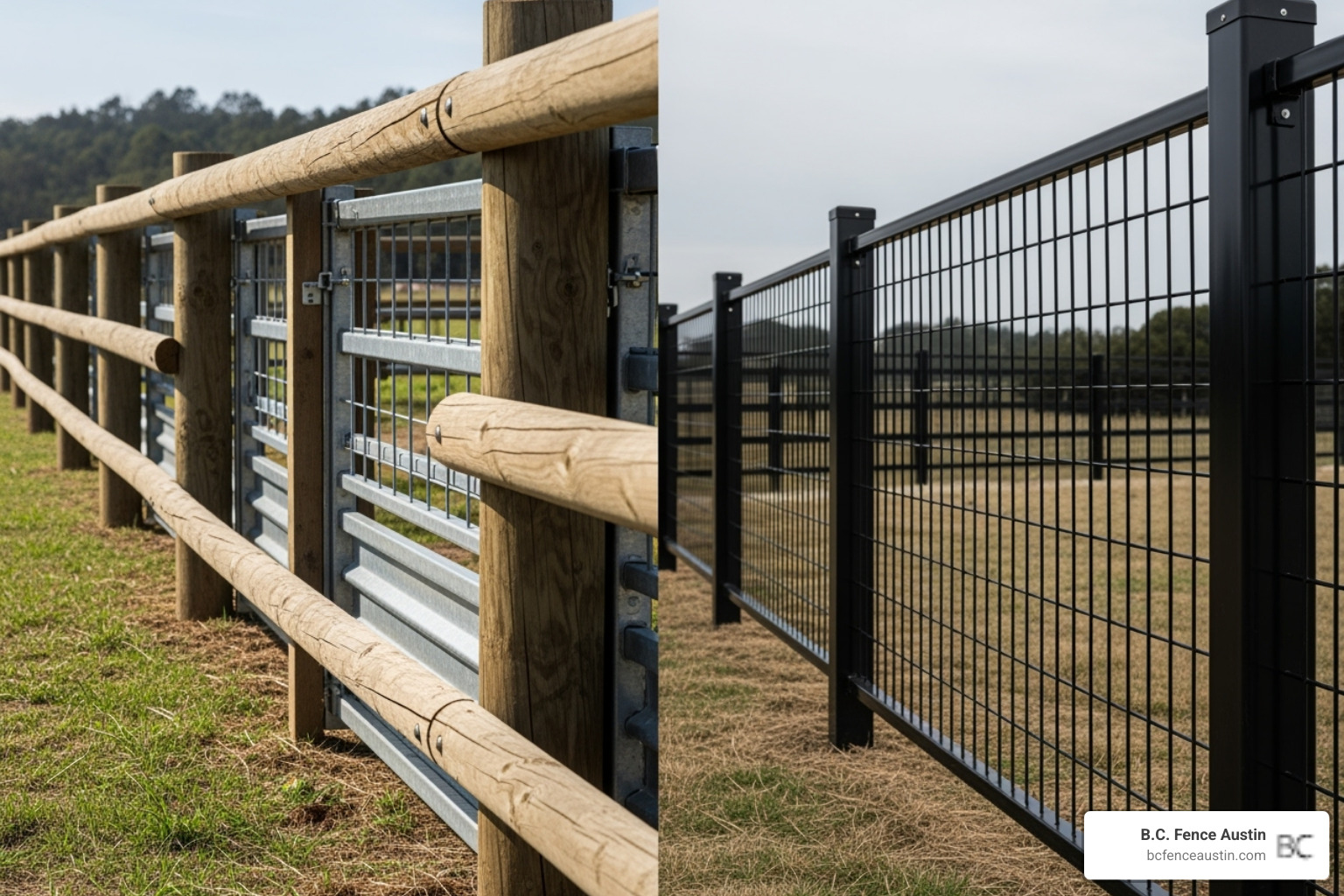
Here’s where decorative cattle panel fences really shine – their amazing ability to fit into completely different design styles. We’ve installed these panels in cozy cottage gardens and ultra-modern downtown properties, and they look perfectly at home in both settings.
For the rustic style enthusiasts, cattle panels paired with natural wood framing create that coveted farmhouse aesthetic. Picture warm cedar posts supporting the galvanized panels, with climbing roses weaving through the wire grid. The combination feels timeless and welcoming, like something straight out of a country living magazine.
On the flip side, these same panels can deliver serious modern design impact. Frame them with sleek metal posts in a black powder-coated finish, and suddenly you have an industrial-chic masterpiece. The clean lines and geometric pattern of the wire mesh complement minimalist architecture beautifully, creating sophisticated boundaries that don’t block your carefully planned sight lines.
The beauty is in the flexibility – the panels themselves stay the same, but the framing and finishing touches completely transform the overall look. You can find more design inspiration in our collection of Fence Designs.
More Than Just a Boundary
Don’t let the name fool you – a decorative cattle panel fence can do so much more than just mark property lines. These versatile panels are like the Swiss Army knife of outdoor projects.
One of our favorite applications is using them as a garden trellis. The sturdy wire grid provides perfect plant support for climbing plants like beans, cucumbers, and flowering vines. You can even bend panels into beautiful garden arches that create stunning entrances to different areas of your yard. For a detailed guide on this technique, check out this helpful resource: Cattle Panel Trellis: How to Build a DIY Vegetable Garden Arch.
The vertical gardening possibilities are endless. We’ve seen homeowners create living walls of vegetables and flowers that would make any Instagram gardener jealous.
But the creativity doesn’t stop with plants. These panels work wonderfully for dog runs, giving your furry friends a secure space while maintaining visibility. They also make excellent patio railings that offer safety without blocking views of your beautiful landscape.
Whether you’re planning a decorative fence or exploring other outdoor applications, our guide to Residential Fence for Outdoors can help you find even more possibilities for your property.
How to Build Your Decorative Cattle Panel Fence
Building your own decorative cattle panel fence is one of those satisfying DIY projects that makes you step back and think, “I actually built that!” While cattle panels are incredibly strong on their own, they need proper framing and solid posts to create a fence that’s both gorgeous and built to last.
The key difference between installing a basic farm fence and creating a decorative one lies in the details. We’re not just throwing up panels to keep animals in – we’re crafting something that adds real beauty to your property. This means paying extra attention to your framing materials, ensuring perfectly straight lines, and choosing finishes that complement your home’s style.
Don’t worry if you’re not a seasoned builder. With the right planning and a methodical approach, this project is well within reach for most homeowners. Just remember to take your time with each step – rushing through the installation will show in the final result, and nobody wants a wonky fence!
Step 1: Planning Your Decorative Cattle Panel Fence Project
Every great fence starts with a solid plan, and trust us, the time you spend planning now will save you headaches later. There’s nothing quite like getting halfway through installation and realizing you forgot about that sprinkler line or miscounted your panels.
Start by measuring your area carefully and marking out your fence line with stakes and string. This simple step gives you a bird’s-eye view of exactly where your fence will go and helps you spot any potential problems before you start digging. Walk the line a few times – you’d be surprised how many rocks, roots, or slopes become obvious once you really look.
Next, check your local regulations and HOA guidelines. Different areas around Austin, Cedar Park, Georgetown, and other surrounding communities have varying rules about fence height, setbacks from property lines, and materials. Some neighborhoods require permits, while others just need a quick approval from the architectural committee.
Finally, think about gate placement now, not later. Consider how you’ll access different areas of your yard, where utilities might run, and how the gate will look from your house. A well-placed gate becomes a natural focal point, while a poorly positioned one can disrupt the entire design flow.
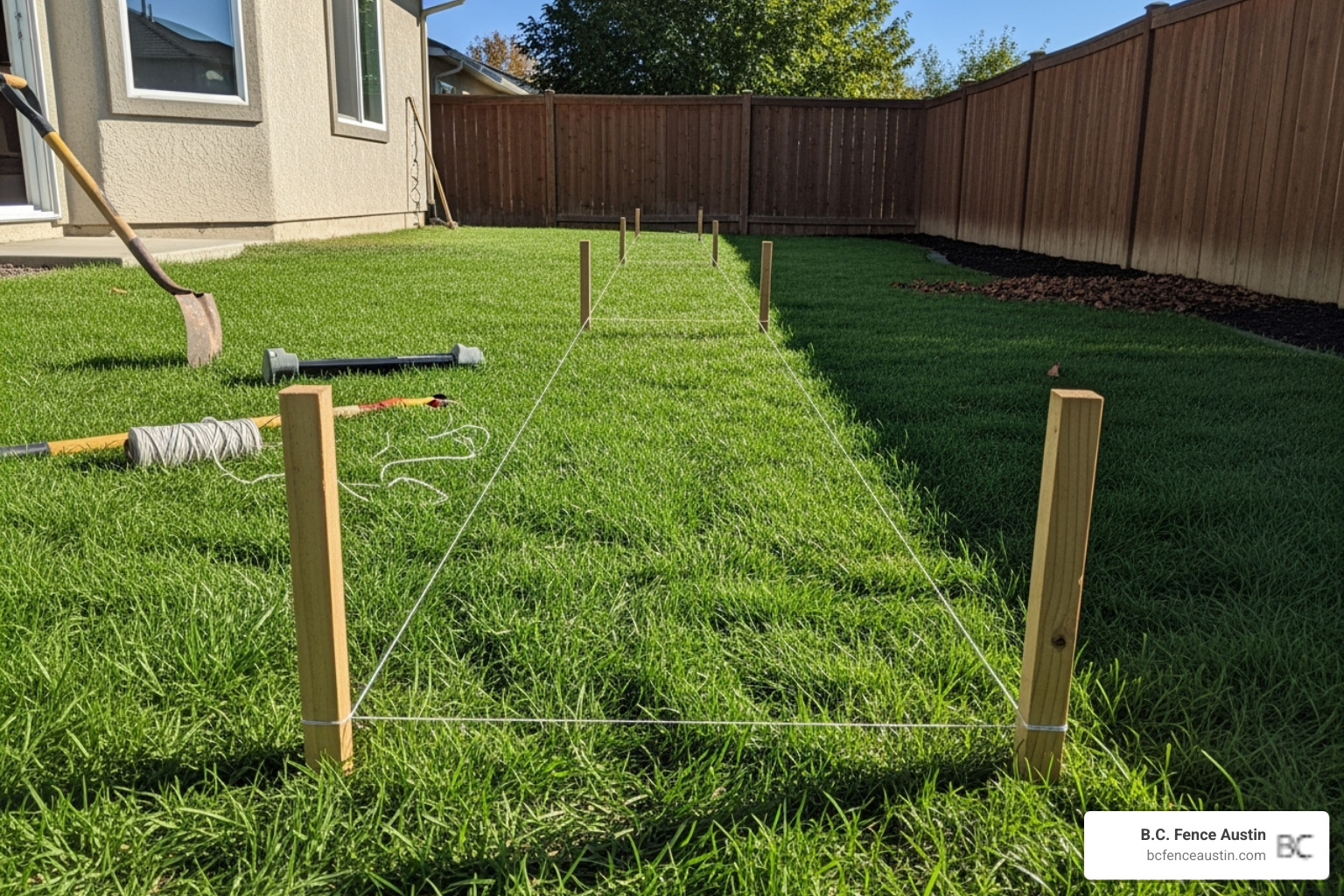
Step 2: Gathering Materials and Tools
Getting your materials right from the start makes the difference between a fence that looks professional and one that screams “weekend warrior.” Quality materials aren’t just about durability – they’re about creating something you’ll be proud to look at for years to come.
Cattle panels themselves are fairly standard – typically 50 inches tall and 16 feet long with that distinctive grid pattern. The real decision comes with your framing materials. Wood frames using cedar or pressure-treated lumber give you that classic, warm look that pairs beautifully with traditional homes. Metal frames, especially powder-coated steel, offer a sleek modern appearance and will outlast wood by decades.
For posts, you’ll want something substantial – 4×4 or 6×6 pressure-treated lumber for wood frames, or galvanized steel square tubing for metal applications. Your posts are doing all the heavy lifting, so don’t skimp here.
Your essential toolkit includes cattle panels (based on your measurements), concrete mix for setting posts, U-clips and heavy-duty screws for attachment, a level (seriously, use it constantly), a post-hole digger, bolt cutters for any panel modifications, and a sledgehammer for driving any T-posts.
When choosing panels, cattle panels work better for decorative applications than hog panels. Cattle panels have larger, more uniform openings that create cleaner sight lines and work better with climbing plants. Hog panels have smaller openings at the bottom that can look busy in a decorative setting, though they’re great if you’re containing smaller pets.
| Feature | Cattle Panels | Hog Panels |
|---|---|---|
| Typical Height | 50 inches | 34-36 inches (can vary) |
| Typical Length | 16 feet | 16 feet |
| Opening Size | Larger openings, often 6″x8″ or 8″x6″ squares | Smaller openings at the bottom, graduating larger |
| Primary Use | Containing larger livestock (cattle, horses) | Containing smaller animals (hogs, goats, dogs) |
| Aesthetic | More open, clear visibility | Denser at bottom, less see-through |
| Durability | Strong, four-gauge galvanized wire | Strong, often four-gauge galvanized wire |
| Best for Decorative | Ideal for open, modern, or rustic aesthetics; trellises | Great for pet containment, garden borders, or where bottom security is needed |
Step 3: Installation and Assembly
Here’s where your planning pays off and your decorative cattle panel fence starts becoming reality. Take your time with this step – a fence that’s slightly crooked or wobbly will bug you every time you look at it.
Setting your posts is absolutely critical. Dig holes about 2 feet deep, spacing them every 8 feet for optimal support. Use a post-hole digger if you can – your back will thank you later. Pour concrete around each post and use your level religiously to make sure everything is perfectly plumb. Let that concrete cure completely before moving on. We know it’s tempting to keep working, but patience here prevents problems later.
Once your posts are rock-solid, attach your framing. Wood frames get secured with galvanized screws or bolts, creating a rigid rectangle for each panel. Metal frames can be bolted or welded in place, depending on your setup. The frame is what transforms basic cattle panels into something that looks intentionally decorative.
Securing the panels is the fun part where everything comes together. Position each panel within its frame, making sure it’s taut and sitting flat. Attach using U-clips, heavy-duty screws, or specialized brackets – whatever works best with your frame material. If you’re connecting multiple panels end-to-end, overlap them slightly and use wire ties or connectors to create one continuous run.
For gate installation, build a frame using your chosen material and attach a cattle panel section. Install proper gate hardware like hinges and a latch that matches your overall design aesthetic. A well-built gate should swing smoothly and latch securely – test it several times during installation to make sure everything aligns properly.

Creative Ideas for Your Fence
Now comes the exciting part – changing your basic decorative cattle panel fence into something that truly reflects your personality! We’ve seen homeowners create absolutely stunning results by thinking outside the box and adding their own creative touches.
The beauty of cattle panels lies in their simplicity – they provide the perfect canvas for your imagination. Whether you want to create a cozy cottage garden feel or go for a sleek contemporary vibe, these versatile panels can adapt to your vision with the right finishing touches.
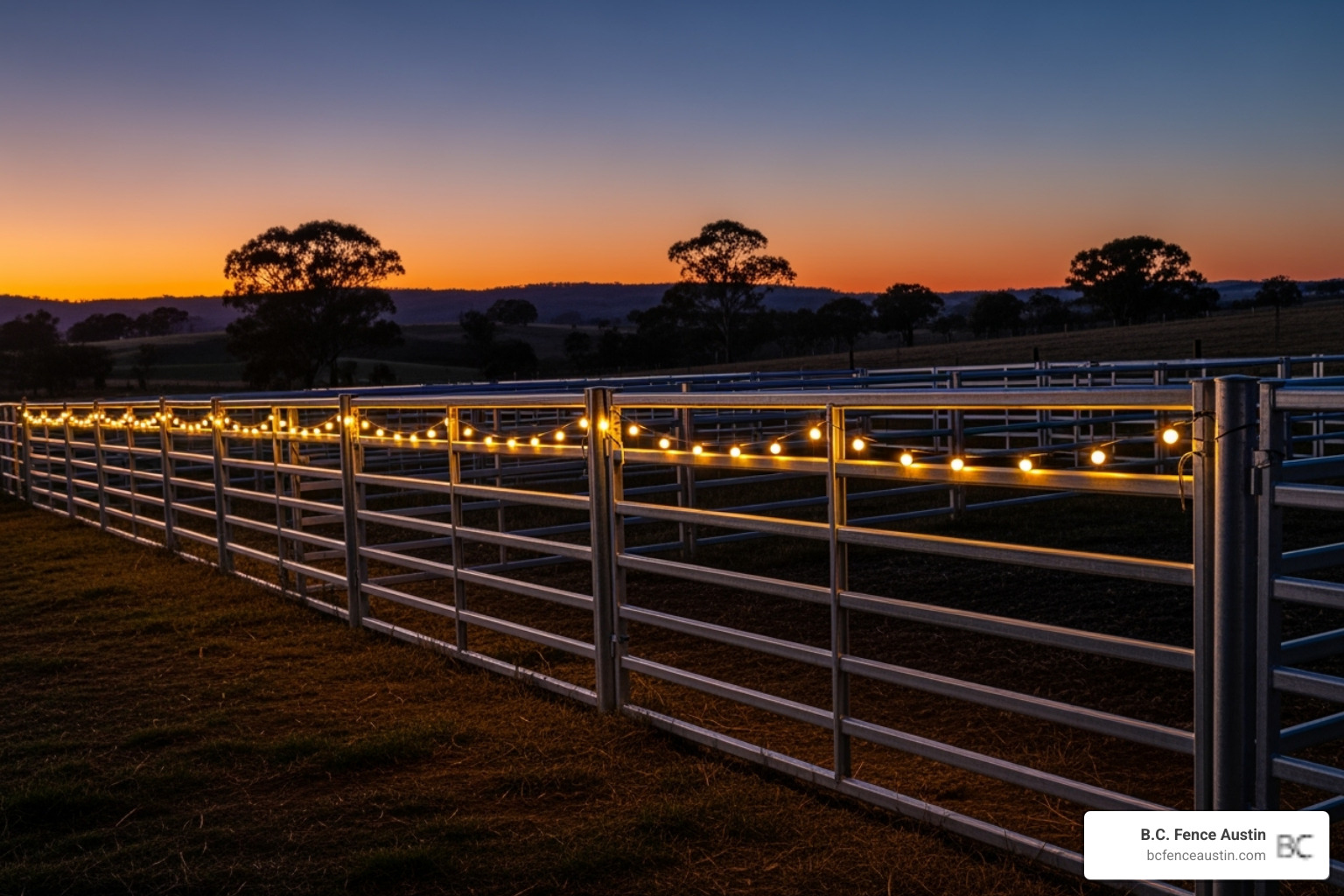
Combining Materials for a Unique Look
The magic happens when you start mixing materials with your decorative cattle panel fence. We love seeing how different textures and elements can completely transform the character of these practical panels.
Wood frames remain a favorite choice for good reason. Cedar posts and rails bring natural warmth and that coveted farmhouse charm to any yard. The honey tones of cedar age beautifully, developing a silvery patina over time. For something with more character, reclaimed wood adds instant history and personality to your fence line.
Want to make a bold statement? Stone pillars at regular intervals create an impressive, almost estate-like appearance. The rough texture of natural stone plays beautifully against the clean lines of the metal panels, giving you that perfect blend of rustic and refined.
For those leaning toward a more modern aesthetic, metal frames in black powder-coated finish create crisp, clean lines that feel fresh and contemporary. This approach lets the geometric pattern of the panels become the star of the show.
Don’t overlook the power of integrated lighting! Solar lights woven through the panels transform your fence into a magical feature once the sun goes down. Warm LED string lights create an inviting glow that’s perfect for evening gatherings or simply enjoying your backyard after dark.
Adding cedar caps to the top rail gives your fence a finished, professional look while creating convenient spots for displaying potted plants or seasonal decorations. It’s these thoughtful details that lift a simple fence into something truly special.
Customizing Your Decorative Cattle Panel Fence with Finishes
The finish you choose can completely change the personality of your decorative cattle panel fence. It’s amazing how a simple color change can take the same panels from farmhouse rustic to sleek and modern.
Many homeowners love the authentic natural galvanized look. There’s something honest and unpretentious about the silvery-gray zinc coating that feels right at home in both rural and urban settings. This finish requires zero maintenance and develops a subtle patina over time that many find quite appealing.
A black finish has become incredibly popular, and for good reason. Black cattle panels create dramatic contrast that makes your landscaping absolutely pop. Green foliage looks more vibrant, colorful flowers appear more brilliant, and the overall effect is surprisingly sophisticated. Some folks say their black cattle panel fence gives them that expensive wrought iron look without the hefty price tag.
But don’t feel limited to black! Paint options are endless – hunter green helps the fence blend into garden settings, while white creates a bright, cottage-style feel that’s particularly charming with climbing roses or morning glories.
If you decide to paint your panels, here’s something important to know: painting galvanized metal requires the right approach. The zinc coating that protects your panels from rust can make paint adhesion tricky. Always use a primer specifically designed for galvanized surfaces, and test a small area first to ensure good adhesion.
For those who want something truly unique, consider a rust effect finish or powder coating in custom colors. These professional finishes offer durability and can create exactly the look you’re dreaming of for your space.
Frequently Asked Questions about Decorative Cattle Panel Fences
Building a decorative cattle panel fence brings up plenty of practical questions, and we’re here to help! Over the years, we’ve helped countless homeowners steer the ins and outs of these versatile fences. Here are the answers to the most common questions we hear.
Can cattle panels be cut to a custom size?
Yes, absolutely! One of the great things about working with cattle panels is their flexibility when it comes to sizing. While they typically come in standard 16-foot lengths, you can easily trim them down to fit your exact needs.
For most cutting jobs, a good pair of bolt cutters will handle the four-gauge wire beautifully. If you’re dealing with multiple cuts or want cleaner edges, an angle grinder with a metal cutting wheel is your best friend. Just remember to gear up properly – safety glasses and gloves are non-negotiable when working with metal.
This custom fitting ability opens up so many creative possibilities. Need a shorter section for a garden gate? No problem. Want to create a unique garden feature? Easy to do. The ability to cut panels means you’re not stuck with standard sizes, making your fence truly fit your vision.
How do you create privacy with a cattle panel fence?
The open design of a decorative cattle panel fence is part of its charm, but we totally understand when you need a bit more seclusion. The good news? There are several beautiful ways to add privacy without losing that distinctive cattle panel look.
Our favorite approach is using climbing vines and fast-growing plants. Imagine morning glories weaving through your fence panels, or fragrant jasmine creating a living privacy screen. For something more practical, try pole beans or cucumber vines – you’ll get privacy and fresh vegetables for your dinner table.
If you prefer a quicker solution, consider weaving wood slats through the panel openings. Thin cedar or pine boards can be woven horizontally to create an attractive semi-private barrier. You can also attach privacy screens made from bamboo or fabric to specific sections where you need the most coverage.
A layered design approach works wonderfully too. Keep your cattle panels as the main structure, then add privacy elements only where needed. This way, you maintain those beautiful sight lines in some areas while creating intimate spaces in others. It’s all about finding the right balance for your lifestyle and protecting your outdoor space effectively.
What is the best way to frame a decorative cattle panel?
Framing is absolutely essential for any decorative cattle panel fence because the panels need that rigid support to stand strong and look their best. Your framing choice really comes down to the look you’re going for and how much maintenance you want to deal with down the road.
Wood frames are incredibly popular, and for good reason. Cedar gives you that gorgeous natural look while fighting off rot and insects naturally. Pressure-treated wood is another solid choice that offers great durability. Wood frames bring that classic farmhouse charm and work beautifully with almost any landscape style. That wood does need some TLC over the years – regular staining or sealing will keep it looking its best.
Metal frames are the champions of longevity and low maintenance. These steel beauties can last for decades without the rot concerns that come with wood. A black powder-coated metal frame creates that sleek, modern industrial look that’s so popular right now. While the upfront investment might be higher, you’ll save time and money on maintenance in the long run.
Both options provide excellent support for your panels. If you’re leaning toward the rustic, farmhouse aesthetic, wood is your friend. If you prefer clean, modern lines with minimal upkeep, metal is the way to go. Want to explore the best options for your specific situation? Check out our guide on what are the best livestock panels to help you make the perfect choice.
Conclusion
Building a decorative cattle panel fence is more than just installing a boundary – it’s about creating something beautiful that truly reflects your personal style. Throughout this guide, we’ve seen how these versatile panels can transform any yard, whether you’re going for that cozy rustic farmhouse feel or sleek modern minimalism.
The beauty lies in their incredible adaptability. Your cattle panel fence can serve as a stunning property boundary, a functional garden trellis for climbing plants, or even a stylish backdrop for outdoor entertaining. The combination of durability from that four-gauge galvanized wire and endless aesthetic possibilities makes these fences a smart investment for any homeowner.
There’s something deeply satisfying about tackling this as a DIY project. When you step back and admire your finished fence – perfectly framed, securely installed, and customized to your vision – you’ll feel that wonderful sense of accomplishment that comes from creating something with your own hands. Plus, you’ll have achieved professional-looking results while staying within your budget.
The impact on your property goes beyond just looks. A well-designed decorative cattle panel fence genuinely improves your home’s value and curb appeal. Whether you’ve chosen warm cedar framing with climbing roses or sleek black metal with integrated lighting, you’ve created a feature that will be enjoyed for years to come.
Of course, we understand that not every homeowner feels ready to tackle a fencing project solo. Maybe your design vision is particularly complex, or perhaps you simply prefer to have the peace of mind that comes with professional installation. That’s where our expertise at B.C. Fence Austin comes in.
We specialize in creating aesthetic and secure fencing options that improve property value throughout Austin TX, Cedar Park TX, Leander TX, Liberty Hill TX, Round Rock TX, Georgetown TX, Pflugerville TX, Lago Vista TX, and Jonestown TX. Our experienced team handles everything from initial design consultation through final installation, ensuring your cattle panel fence is built to last and perfectly matches your vision.
For a flawless and durable installation that transforms your property exactly as you’ve imagined, explore our decorative cattle panel services to bring your project to life.
